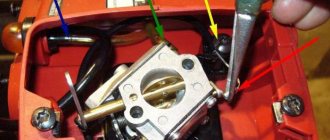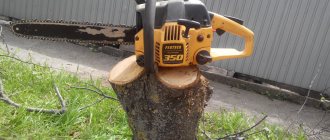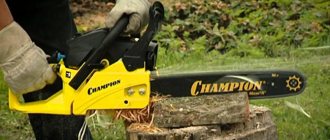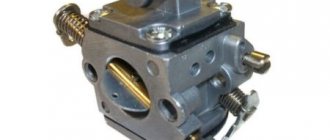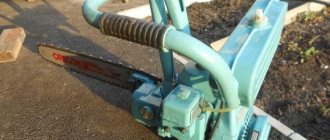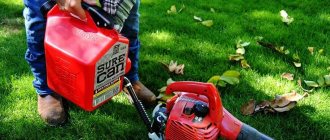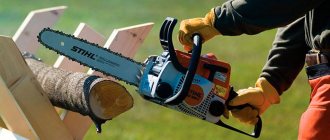Where to start adjusting the carburetor on a chainsaw
- First you need to remove it.
- Therefore, we stock up on a 4 hex wrench.
- Remove the air filter cover, then the filter itself unscrews the spark plug.
- After this, use a hex wrench to unscrew the 5 bolts and remove the top cover of the chainsaw.
- Take a flathead screwdriver and unscrew the two bolts that hold the carburetor.
- After removing the carburetor from the saw, we begin to clean and wash it.
- After washing and drying, we identify all the shortcomings; in many cases, adjustment may not help simply because the air well cover has been eaten.
- Only after a complete inspection can you begin adjusting the product.
The adjustment is simple in principle and has been described more than once on our website prokarbyrator.ru.
On this saw the instructions say 3300 cycles, the chain thickness here is zero 3.25. And if the thickness of the chain is thinner, then the number of turns at idle will be less, but at the same time the high speed will increase. On this saw, the maximum number of high cycles is 11,000. The manufacturer's instructions recommend working not at full throttle, but at 80 percent. At eight thousand revolutions, sawing is performed. For saws with thinner chains, the speed is more than 11 thousand, and can reach up to 13,000, that is, you need to look at the specification.
Adjusting the chainsaw carburetor
We recommend adjusting the chainsaw carburetor at a service center. since this process requires certain knowledge and experience. In addition, special tools are required: an adjusting wrench and a tachometer. We strongly advise against adjusting the carburetor yourself, but we understand that there are situations when the service center is very far from you, and there is no way to get to it, but the work is worth it!
If the chainsaw does not start, then read our article The chainsaw will not start. What to do?. and calmly and consistently go through all the points in order. If the chainsaw starts, but does not pick up speed or is unstable, or stalls at idle, then in this case you can try to fix it yourself.
First: preparing to adjust the carburetor
Before adjusting the chainsaw carburetor, you need to make sure the air and fuel filters are clean. If you undertake to adjust the carburetor, then, of course, you know where these filters are located and how to check their condition. Next, inspect the carburetor adjustment screws. It happens that there is only one adjustment screw, as on the Stihl MS 180 chainsaw. Or there are none at all, as on Husqvarna chainsaws with the AutoTune system. But, as a rule, there are three screws.
Second. idle speed adjustment with screw T
Screw T is responsible for idle speed, it is adjusted with a regular screwdriver and, most importantly, it can be adjusted without fear of ruining anything. But before adjusting it, we start and warm up the engine. After the engine warms up, we try to carefully adjust the T screw at idle speed. If you twist it clockwise, the idle speed should increase. When twisted, they will decrease. Be sure to unlock the handbrake and adjust this screw to ensure stable engine operation, but if the chain starts to spin, unscrew the screw a little so that the chain remains motionless at idle speed.
Third. what are the L and H screws for?
Move on to the next screws, adjust them also on a warm engine
They are designated L and H, they need to be adjusted extremely carefully, and here's why. These screws are responsible for the quality and quantity of the mixture during engine operation.
And since a lubricant dissolved in the mixture enters the engine along with gasoline, there is a risk of disrupting the lubrication process or exceeding the maximum permissible engine speed. If you don't have a tachometer, you won't be able to check this. In addition, you do not have a special key and will have to select a hollow tube instead. And it can scroll and mislead you about the position of the screws when you want to put everything back.
Before adjusting these screws, mark or remember their location. It is best to look up the correct screw positions using reference tables. The tables indicate the number of revolutions by which you need to unscrew the screw relative to the state that is screwed in until it stops. This information is necessary if someone before you or you yourself randomly rotated the screws. If no one has previously violated their position, then you can do without this data.
Fourth. elimination of dips in speed gain
If the chainsaw starts, but when you press the gas trigger you feel a drop in speed, then try adjusting screw L. Turn it a quarter turn in different directions and at the same time try the engine’s response to pressing the gas. Try to find a screw position in which engine acceleration will be uniform and fast. There is no point in turning it to a larger angle; the screw cannot unscrew that much on its own, so a quarter of a turn should be enough.
Fifth: adjusting maximum speed
It is generally not advisable to adjust screw H yourself. It is responsible for the quality of the mixture, which affects the maximum engine speed. He also cannot go astray on his own. Therefore, it will be enough if you turn it 1/8 of a turn in either direction and achieve what you consider to be optimal engine operation at maximum gas. But, I repeat, it is better not to do this on your own. To accurately adjust the maximum speed, you must use a tachometer.
There are reasons not related to the carburetor why a chainsaw will start poorly or run erratically. The most common ones are piston wear and air leaks through oil seals or seals. In these cases, adjusting the carburetor or even replacing it will not help. These reasons can be determined by measuring compression or pressure testing the engine. And for this you already need special equipment. It is available in our service center. We can diagnose and determine the cause of the malfunction.
Specifications
The Shtil 250 chainsaw is supplied as standard to the Russian market with two tires of different lengths: 14 and 16 inches. Depending on the task at hand, you can choose any one, with luxury versions such as Shtil MS 250
| Manufacturer | Stihl |
| Model | MS 250 |
| Homeland of the brand | Germany |
| Country of Origin | China |
| Saw class | Semi-professional |
| Engine | |
| Power, hp/kW | 3,1/2,3 |
| Engine capacity, cc. | 45,4 |
| Saw set | |
| Tire length, cm/inches | 40/16 |
| Chain pitch, inches | 3/8 |
| Chain thickness, mm | 1,3 |
| Number of links, pcs | 55 |
| General characteristics | |
| Fuel tank volume, l | 0,47 |
| Oil tank volume, l | 0,2 |
| Warranty, months | 12 |
| Weight, kg | 4,6 |
| How much does it cost, price in rubles | 24 990 |
The weight of the chainsaw is indicated without refueling fluids. Of course, it’s difficult to determine from the characteristics how a chainsaw will behave in practice; to do this, you need to try it at work and compare it with something. To find out how much a chainsaw costs today, we suggest looking at the most current offers from Yandex.Market:
Characteristics of modification C-BE
Due to the presence of a quick chain tension system, the weight of the saw is increased by 0.3 kg and amounts to 4.9 kg. The cost of the improved modification will be approximately 10% higher. Today the current price is 26,990 rubles. All other technical characteristics of the standard and improved model Stihl MS 250 C-BE are the same. Power 3.1 l. s., which translates into 2.3 kW. By the way, this is 0.8 more than the household model Stihl MS 180. Engine speed is 11 - 13 thousand.
Chainsaw Partner 350 – malfunctions and their elimination
Most owners of this Partner model encounter problems that can be considered typical for this configuration of the tool. To be able to eliminate them, you should understand the causes of breakdowns and study the most effective methods of repairing them.
Chainsaw Partner 350 starts and stalls - how to solve the problem?
The most common cause of this breakdown is a clogged air filter. Due to dust, debris and insects, it is not able to pass the amount of air that is necessary for the normal operation of the Partner 350 chainsaw. In this case, you will need to remove the filter and wash it with clean gasoline. If this does not help, then the filter element should be replaced completely.
Another common cause is a faulty spark plug. To check, you will need to unscrew the part and inspect it. If there are small light spots on the spark plug, it means the part is working properly. However, if the ceramic walls of the candle are covered with a thick layer of soot and oil, then it needs to be cleaned. To do this, you need to heat the candle with a lighter and carefully scrape off the carbon deposits. If this does not help, the spark plug will need to be replaced.
What to do if the Partner 350 chainsaw does not start?
In this case, you need to carefully check the ignition system of the tool. Most often, the saw will not start if the gap between the magneto and the ignition coil is broken. In this case, you will need to disassemble the saw and adjust the distance between these parts. If you don’t have a sample on hand, you can use a pocket calendar or a paper business card instead.
Also, the Partner 350 chainsaw may not start due to a clogged fuel filter. If a lot of debris has accumulated in it, then it will not allow the amount of fuel the engine needs to pass through. In this case, the filter will need to be replaced.
The chain on the Partner 350 chainsaw is not lubricated - troubleshooting
The main reason for this malfunction is a loss of tightness or a break in the hose through which oil circulates for the chainsaw chain. In this case, you need to remove the top and side shields of the chainsaw body, and also inspect them for stains. To solve the problem you need to replace the worn hose. When installing, sealant will need to be applied where it is attached to the pump.
If the cause of the breakdown does not lie in the hose, then you need to inspect the oil pump. It may be clogged or broken. If you cannot wash the part, then it is best to replace it with a new one.
Filling a spark plug on a Partner 350 chainsaw - troubleshooting
Often the spark plug on a chainsaw begins to flood due to prolonged use of an incorrectly prepared fuel mixture. If you mix a large amount of oil in gasoline, this will cause the fuel pump to malfunction. Oil will flow from it into the housing, including onto the spark plug of the chainsaw.
Another common problem is a broken fuel pump. To check its operation, you should remove the tool body and start the engine. Next you need to press the gas trigger several times. If oil flows out of the pump, it means it is faulty.
As a rule, chainsaw fuel pumps cannot be repaired. It's best to replace it completely. To extend the life of the new pump, in the future you need to use only high-quality fuel and motor oil to refuel the Partner 350 chainsaw.
How to assemble
After all repair work has been completed, the quality of the reassembly is of great importance. Incorrect placement of the part can lead to equipment failure and be unsafe for humans.
- The most important part is assembling the saw set. It is better to do it with protective gloves to avoid cuts from the stars. When installing the chain on the bar, pay attention to the direction of the edge of the teeth. It should go forward, along the top of the tire. Place the mechanism on the drive sprocket. Replace the clutch cover and tighten the nuts.
- Use a special wrench to tension the chain. The quality of this work affects the safety and efficiency of equipment operation in the future. A poorly tensioned chain will fly off, and a tight tension will cause rapid wear. The chain can be raised above the bar no more than 1 cm. Check rotation and tighten the nuts.
Any repair work on complex equipment should be carried out carefully. It is better to use original spare parts for this. Other options may negatively affect the life of the device. If you are not sure that you can handle it yourself, it is better to contact a specialized workshop.
This is especially applicable for expensive professional equipment. Incorrectly performed repairs can lead to failure of the entire mechanism. To prevent breakdowns, try to follow the requirements of the operating instructions, maintain the tool on time, monitor the mechanisms, use high-quality oil and fuel, and replace wear parts.
There is little oil in the fuel mixture
First, let's look at the most unpleasant case. Why? Because before manipulating the filters, it is better to make sure that the oil and gasoline are mixed in the correct ratio.
Here, however, it is worth noting that if you have already started your saw many times (for example, ten times), but continues to start, and then stall again when the speed increases, then apparently everything is in order with the fuel. Otherwise, it would simply stop starting altogether.
But still, I recommend immediately dispelling the slightest doubt about the quality of the fuel as soon as your saw stalls when picking up speed for the first time. Because if the reason is fuel, then, as mentioned above, you can end up with expensive repairs. And so, everything can still work out. To dispel doubts is to drain the old fuel from the tank and fill it with freshly prepared fuel, in which oil and gasoline are mixed in the correct proportions.
It is better to look at the instructions for the saw for the correct ratio. If you have lost it, then look at the ratio on the oil package. Usually it is 1:50 or 1:40. If the oil used is “non-native” (well, for example, for Stihl chainsaws there will be little Stihl “native”), then I recommend using a proportion of 1:40, even if the oil package says 1:50.
For accurate dosage, I personally use a medical syringe and a measuring container in which one liter of gasoline can be clearly measured. I pour a liter of gasoline into a container, fill a syringe with 25 (at 1:40) or 20 (at 1:50) cubes of oil and add it to the gasoline.
After preparing a new mixture, we drain the previous mixture from the tank, which we are unsure of, and fill it with fresh, just prepared one.
Now that you have done everything to dispel any doubts about the quality of the fuel, let's move on to further actions.
As I wrote above, if there is a lack of oil, scuffing can form on the piston and cylinder walls - and they almost always do. If you are lucky and no scuffs have appeared, then with a new fuel mixture prepared in the correct ratio, the chainsaw should start working normally.
If scuffs appear, the saw may start and stall several more times, after which it will stop starting altogether. In this situation, I sympathize with you, since, most likely, now you will need to replace the piston group, which will be very expensive.
If the saw, as before, starts and stalls at high speeds, then we manipulate the filters.
Chainsaw Shtil stalls: reasons
If the tool turns off immediately after starting, it means that some device or part has broken down. To determine the cause, the mechanism is tested independently or in service workshops. Sometimes the reason that the mechanism does not start well is improper maintenance of the saw:
- insufficient amount of gasoline;
- poorly prepared fuel mixture;
- poor quality of lubricant;
- muffler clogged with combustion products;
- unadjusted carburetor;
- obstruction of the air filter;
- piston or cylinder failure.
When you press the gas
The sawing units operate at idle speed, but the chain saw stalls when the gas is pressed, as the load increases. Before use, warm up the tool by running the engine at idle speed for a minute. If this is neglected, the motor stops after pressing the pedal. Other reasons may be:
- clogged or unregulated fuel mixing unit;
- a clogged air filter does not provide the required air flow when the load increases;
- a dirty gasoline filter does not allow the required amount of mixture to pass through;
- the cylinder and piston walls rub.
A low octane number of fuel causes brakes, since this circumstance prevents the engine from achieving the required power when the load increases.
At idle
Violation of the functionality of the fuel unit system leads to air leaks. In this case, the unit stalls at idle and does not maintain its number. Additional suction reduces the air impulse to the fuel pump and passes through the sump membrane or crankshaft seals. Diagnostics is done with a vacuum gauge.
Stopping the engine when cold occurs for other reasons:
- the spark plug channel contains an excess amount of combustible mixture;
- the gap between the tip of the spark plug and the high-voltage cradle is not adjusted;
- power supply failure.
Check the seals by pouring gasoline into the crankcase; the leak is visible visually. This means that the engine does not operate at idle speed, and at high frequencies, leaky oil seals will lead to bearing jamming. If elements leak, they are replaced with new ones and sealed.
Full speed ahead
Sometimes the engine stalls after normal operation
To establish the cause, pay attention to the accompanying circumstances:
- The engine stalls in the middle of operation for no apparent reason. The starter is in a stationary position and does not turn. This means that the tool is jammed and requires urgent repair.
- During normal operation, power decreases in a short time and the engine stops, the cylinders are overheated. The situation indicates an air leak under the rubber pipe between the carburetor cylinder, possibly due to a rupture. The air becomes depleted of fuel; the pipe needs to be replaced.
Not gaining momentum
Many mechanism systems are involved in the startup, so the loss of speed of the Stihl chainsaw after idling can be a consequence of various factors. Reliable idling and interruptions in the engine under load can occur for the following reasons:
- development of engine life;
- wear, deformation and corrosion of the piston group;
- malfunction of the ignition coil or spark plug;
- unbalance of carburetor screws.
If the tool does not develop speed, then the conductivity of the hole in the fuel tank cap is impaired. The occurrence of a vacuum does not provide the required amount of fuel, so the engine does not gain the required power. The speed decreases when carbon dioxide accumulates in the muffler, and the removal of combustion gases is difficult.
Doesn't slow down
The tool quickly reaches maximum speed without losing power. This situation is explained by the fact that:
- the throttle valve does not work due to a weakened spring or traction element;
- the switch on switch periodically fails;
- there is no corkscrew on the throttle axis;
- the carburetor is clogged;
- The fuel hose and gasoline filter are not functioning properly.
Conclusion
If the first signs of loss of power (reduction in speed) appear with the Shtil MS 180 chainsaw, under no circumstances should you continue to work, but you should immediately contact a specialist or carry out diagnostics and fix the malfunction yourself. There are not many reasons for power loss and you can cope with them even without certain skills.
A chainsaw in a country house or in a private house is a common occurrence. It can be amateur, semi-professional and professional. The choice depends on the frequency and complexity of the activity. It greatly simplifies the work of collecting firewood and helps to quickly set up a log house. If it breaks down, in most cases it is possible to repair the chainsaw yourself. Equipment failure may be associated with idle speed problems, the mechanism does not start or malfunctions.
The repair principle for all chainsaws is approximately the same. Before work, be sure to read the instructions. With this type of equipment, the greatest difficulty is not the repair itself, but the search for the source of the breakdown.
Troubleshooting a chainsaw carburetor
Remove the carburetor from the chainsaw. Remove the fuel pump cover with the membrane by unscrewing one screw in the center of the cover. Next, turn the carburetor towards you with the throttle valve, on the side where there are two holes, in one you can see a pin, and under it there is an accelerator pump. Remove the retaining ring from the outside of the pin and disconnect the wire spring of the air damper. Unscrew the screw in the center of the throttle valve, remember how the throttle valve is positioned (so that you can put it that way later) and remove the throttle valve. Plug the hole with the pin with your finger (the accelerator is spring-loaded and if you remove the throttle axis and do not close the hole, the accelerator will pop out), then turn the throttle axis and remove it. Shake the accelerator (piston) with the spring out of the hole. There is a rubber cuff (ring) on the piston - its wear is what causes the chainsaw to malfunction. It is necessary to replace the piston with a rubber cuff and a spring (they are sold as a repair kit). Or you can remove the worn piston with the spring, and plug the hole by pushing a rubber plug in there (the chainsaw will not have an accelerator pump, that is, it will accelerate not in 3 seconds, but in 4 seconds, but it will work well since there will be no suction air from the carburetor).
Assembly after troubleshooting the chainsaw (after eliminating the malfunction of the chainsaw carburetor) is carried out in the reverse order of disassembly. When assembling the throttle valve, before tightening the screw, the throttle valve itself must be positioned correctly so that it does not jam, and the threads of the screw securing the throttle valve to the axle should be degreased and coated with a special thread sealant (sold in small tubes, red, liquid) or flattened with pliers, because if this bolt gets unscrewed during operation, it goes straight into the cylinder) and repair or replacement of the piston cannot be avoided). So we looked at how to fix this chainsaw problem.
Chainsaw Shtil 180 - design and adjustment of the carburetor
The stihl ms 180 chainsaws are designed to make their operation as easy as possible for inexperienced users. To achieve this, the saw's carburetor has been eliminated from some settings available on more powerful Stihl models. But there is still an opportunity to configure it, and repairs, as well as adjustment of the carburetor of the Shtil 180 chainsaw with your own hands, are possible.
IMPORTANT. An experienced electrician leaked the secret of how to pay half as much for electricity, a legal way
Read more
To come in
Already registered? Sign in here.
There are currently 0 users on the page
There are no users viewing this page.
Among the entire range of chainsaws of the German brand Stihl, the MS 180 model is in highest demand among gardeners. The advantages of this reliable household tool include reliability, increased endurance and an impressive working life. The Stihl 180 chainsaw is distinguished by its ease of maintenance and high repairability, which makes it possible for any novice gardener to use it confidently.
Why doesn't a chainsaw lose steam?
There may be several reasons why a chain saw does not lose momentum:
- throttle spring broken;
- jamming of the throttle trigger;
- Throttle valve socket is bent;
- Lost the corkscrew of the throttle shaft, causing it to jam.
It is not difficult to solve all these problems; it is necessary to conduct a careful inspection and accurately determine the cause, and then change the defective part. Generally, if the chainsaw is revving, idling and has normal power, then the problem is that it is not slowing down, it is purely mechanical. And finding and fixing a mechanical fault is much easier than identifying and stopping the air intake in the chainsaw crankcase.
Sags crookedly
Let's look at the reasons why a chainsaw cuts crookedly. This manifests itself during cutting under the load of the trunks, when the tire gradually moves to the side. This is especially noticeable when sawing a wide trunk using the double cut method, first from above, then from below. As a result, the output is an uneven sawn surface, which in some cases is unacceptable. An example is trimming bars.
- Uneven sharpening of saw teeth. This is the most common reason why the device cuts obliquely. The teeth should be ground to the same distance to avoid problems when sawing. The optimal solution is to purchase a sharpening machine that is adjusted to the most worn tooth of the saw mechanism. Or contact a workshop where such equipment is available. The result is that all teeth are the same size.
- The chain or bar used is not suitable. When purchasing these elements, you must consider the width of the groove. This is important not only for the correct operation of the equipment, but also for safety when cutting.
- The saw set of the device is very worn. If the device does not cut well, there may be increased wear on the headset. A visual inspection will indicate the problem. If the right or left side of the tire is more worn, it must be replaced with a new one. If there is increased wear, it makes sense to conduct a full diagnosis of the lubrication system. This often causes increased wear on one side of the chain.
In case of complex repairs, it is better to take the equipment to a specialized workshop.
Sore spots Shtil 180
Every instrument has problems and the 180 is no exception, but the most painful place is the 100% air filter. Replacement filter element 180 - open "G".
Why the Germans don’t change the design and put a multi-use mesh filter on this model instead of a piece of something unknown, through which all the garbage flies into the carburetor, only God knows. Maybe this was done on purpose?
Well, the filter needs to be changed regularly. I don’t recommend washing it to anyone, because... after that it loses its shape and may leak at the joints with the body.
The second problem is the crankshaft seals. Many times I was faced with a situation where, even if the bearings were in good condition, the seals poisoned, air got into the crankcase, the maximum speed increased, with all the consequences, even to the point of scuffing the piston. Whether it is a manufacturing defect or operating conditions, the fact remains that oil seals often cause serious problems with the engine.
Replacing the piston
Method of action for replacing and installing the piston:
- Prepare a hammer, a wrench, a huge flat-head screwdriver, a set of sockets and wrenches, and a compressor to clean the accessories.
- Remove the top protective cover.
- Unscrew the spark plugs.
- Remove the side cover.
- Remove the plug from the shock absorbers.
- We secure the crankshaft with a cord, unscrew the clutch and flywheel nut.
- Removing the chain drive sprocket.
- Removing the carburetor, ignition module and exhaust system.
After which you can dismantle the piston mechanism.
Chainsaw malfunction Shtil 250 (chainsaw carburetor malfunction):
Immediately after starting, the chainsaw operates at high speeds, and if you press the gas, instead of starting to accelerate, it “chokes” and even stalls. Or it starts poorly, does not pick up speed and stalls (this chainsaw malfunction also applies to other expensive chainsaws with an accelerator pump in the carburetor).
Cause of chainsaw malfunction:
Wear of the rubber cuff on the piston of the accelerator pump in the carburetor (fuel accelerator). This leads to air leakage from the accelerator pump and the main jet supplies a lean fuel-air mixture (there is little gasoline in the mixture) into the diffuser, and the chainsaw first operates at high speeds, and then “chokes” and stalls. This happens after 2-3 years of operation and usually happens in the hot summer months.
Reference!
Adjusting the carburetor of the Shtil chainsaw will be required when the properties of the fuel change, the altitude above sea level, when the Shtil chainsaw is in use (air rarefaction), and also when the atmospheric pressure, temperature and humidity change. Adjusting the chainsaw carburetor allows you to achieve good chainsaw performance when external operating conditions worsen. Also, adjusting the chainsaw carburetor helps prevent oil starvation and engine breakdown due to insufficient lubrication entering the cylinder with a lean fuel consistency.
Chainsaw calm idle speed adjustment video.
Tip: To check the density of the motor, it is great to use a special device, i.e. special pump with pressure gauge. First, you need to remove the carburetor on the chainsaw, and install a sealed plate plug with a flange on the inlet window of the cylinder to connect the hose from the pump. There is also an option to place the spark plug on sealant for tightness. You also need to remove the muffler and install a sealed plate with a rubber gasket on the cylinder exhaust window. Then you need to put the piston at top dead center and connect the hose from the pump to the flange. Next, you need to pump air into the engine to 0.9 atm. and look at the pressure gauge needle - if it stays in one place, it means the piston engine is sealed. Then we release the air, switch the device (pump) and begin to pump out the air from the cylinder, creating a vacuum in the engine with a pressure gauge reading of 0.5 atm. We look at the pressure gauge needle - if it is in the workplace, it means there is no air leakage through the oil seals, or other seals in the engine (which aggravates the operation of the chainsaw and does not make it possible to correctly adjust the chainsaw carburetor). In this way we check the engine for air leaks and compression.
Why does a chainsaw stall when the accelerator is pressed - to summarize
When making an upgrade for the reasons why the saw stalls after you press the gas, it is necessary to take stock of all possible reasons and eliminate them. The reasons can be divided into two parts - simple and complex. You need to start troubleshooting with simple causes and end with more complex ones.
You definitely need to start checking from the tank, not from the carburetor, but from the gas tank. Moreover, make sure that the correctly prepared mixture is used. Next, you need to check the serviceability of the muffler and the presence of carbon deposits on the spark plug. After this, you will already have an idea of in which part of the tool you need to look for a breakdown. There may be a breakdown in that. What you need to do is simply turn up the maximum speed, for which you adjust the carburetor. If this does not solve the problem, then you should check the air filter and clean it.
Pay special attention to the carburetor, after cleaning and possibly repairing which the chainsaw should work like new. If even after this the problem remains, then do not be lazy to check the compression value
Perhaps the engine is very weak and needs to be replaced.
https://youtube.com/watch?v=p6QArjhMz8U%3F
At this point, the upgrade to restore the functionality of the tool is completed, and it is worth noting one more point, such as the use of fuel that has been stored for a long time. Many people dilute gasoline with oil and store the mixture for months, and sometimes for six months. This cannot be done in any way, since the mixture has the properties of aging, and therefore, after its preparation, it must be used within 1-2 weeks. If you do not follow this recommendation, you will need to frequently change not only the fuel filters, but also clean the carburetor, but the worst thing is that this contributes to accelerated wear of the CPG.
Muffler inspection and repair
Clogged mufflers should be left to soak in warm water and detergent, then wiped thoroughly and dried.
A malfunction of the muffler leads to a drop in the power of the tool when working and stopping in idle mode.
Despite the apparent simplicity of this detail, it is also important to keep an eye on it. Quite often the muffler becomes clogged
During operation, it is possible that wood dust, sawdust, and resin particles may get on the grate. High temperatures cause them to stick and accumulate; exhaust gases also form deposits on the surfaces of the spark arrestor and other parts. The layer that increases over time reduces the throughput of the muffler and interferes with the normal removal of exhaust gases. The engine, figuratively speaking, is choking.
Repairing this unit is not difficult and is within the capabilities of many tool owners. The device should be removed from the engine, the holes should be covered with a rag or other material. If the resulting layer is too hard, all parts can be left to soak in warm water and detergent. After the plaque has softened, the parts should be washed with a rag or soft brush and wiped thoroughly. Inaccessible areas can be blown with compressed air or dried with a hairdryer. The use of mechanical means of removal is not advisable.
For normal operation of the muffler over a long period of operation, you should use lubricants recommended by the manufacturer, monitoring their expiration dates. The mixture must be prepared immediately before work and consumed completely.


